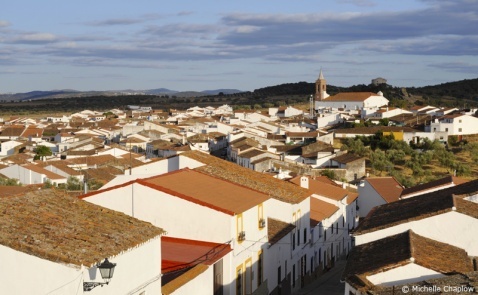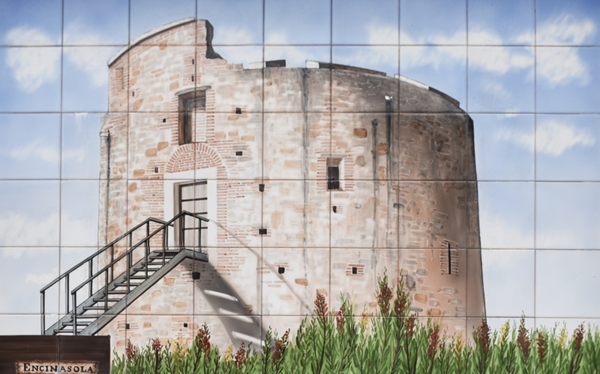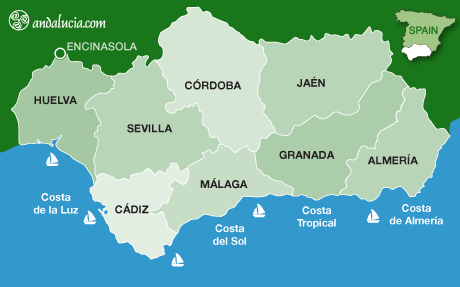
Encinasola in the Sierra de Aracena (Click to enlarge image) © Michelle Chaplow |
|
Encinasola
The town, the most nothern in the province and close to both the Portuguese border a few km to west and the Extramadura border a few km to the North and East. Encinasola has a outlying feel to it and few travellers pass by. Located at 430m above sea leve and has a population of about 1300. Head for the San Andres church and the square next to it. The view from the two forts are also worth the visit.
Thinigs to see
The castle was constructed in the reign of Alfonso X el Sabio but very little remains to be seen today. Later, in 1645 during the War of the Restoration in the reign of Filipe II Rafael de Medicis was sent from Seville to build two new defensive 'Fuertes' (forts or bastians) on hills adjacent to the town; San Felipe y Peña (dedicated to King Filipe II) and the larger Fuerte de San Juan. (dedicated to the nearby hermitage). You can drive with car and with good navigation to visit them. The fort of San Juan has been reconstructed and steps up to the entrance door added. It served as an informatioin point for the Parque Natural Sierra de Aracena y Picos de Aroche but is now locked up. The modern signage and lighting are rotting away. The star shaped double defensive walls foundations can still be seen by walking around the outside of the circular tower. A cannon can still be seen pointing outwards over the wall in the bushes.
In the centre of town is the 16th century Iglesia de San Andrés, three Renaissance facades and a Baroque altarpiece with twisted columns. The construction was started by Diego de Riaño, and after his death was continued by Martin de Gianza and again after his death was finished by the son of the very well known church builder from Cordoba; Hernan Ruiz II. The long constructioni coincided with the transition of architectural syles, for that reason we can see both elements of Baroque and elements of Renaisance. The three dooways are renaisance. North door similar to that of the Andalucia Parliament Building in Seville. South door with ionic columns. The was door is the most monumental with monolitical colums in Tuscany style. The baroque alter was gold leaved in 1715 by Juan Romero. The original tower was destroyed in the Lisbon earthquake of November 1755, the reconstruction is by Pedro de Silva. Facing the town square and built into the exterior wall of the church are two roman plaques. One a gravestone and the other a honour from the emperor with the inscription. "The Emperor Cesar Augusto, invested with the power tribune for the thirtieth time, Pontifex Maximus, Consul for the thirteenth time, Father of the Empire."
Other churches in Escinsola are the Church of the Holy Martyrs or also known as San Sebastian, this is a more modest 18th century single nave church guarding a 16th century image of Our Lady of Grace.
Just outside the town is the simple Hermitage of San Juan. It was re-constructed in 1833 with funds obtained by D. Juan Gualberto González Bravo a villagee who became "Ministro de Gracia y Justicia" under King Fernando VII.
Pilar de Acá is the name for a spring, water tanks, fountain and water trough loacted a few hundred metres from the town just off the H-211. The present construction dates to 1893 and thanks to funds left in the will of Don Juan Gaualberto Gonzalez Bravo. The fountain is also marks the starting point for a number of signed footpaths. It is noted thet the Portugues are now welcome in this area since signage is in Spainsh and Portuguese.
There is the Ermita de la Virgen de las Flores, the patron of the town, built beteen 1585 and 1615. It is 9km from the town. Within the grounds, which are normally kept locked is a recreation area. This is ideal for the celebration of the pilgrimage of Virgen de Flores which is celebrated a week after Easter Sunday each year.
Ermita de Rocamador, is located in the Finica Los Claustros and was built in the 16th Century.
In the countryside, particularly in an area called Pagoroto, one can see 'chozos' or simple mud brick and thatch dwellings used by shepherds.
There is an ancient low stone bridge called Los Cabriles over the River Múrtigas.
There are a number of signed footpaths in the vicinity of the village and a couple of local parks called "Encinasola-Las Contiendas" and "Encinasola-Puerto del Sillo". Encinasola-Las Contiendas is the 10km footpath for the village to the established 'Camino de la Contienda' which is a footpath that unites a number of the castle on the Huelva - Portuguese border.
LOCAL CUSTOMS
Typical handicrafts are ironwork and embroidery. Typical gastronomy is migas with roasted sardines, olives and oranges; el guisado de morcilla lustre, dishes elobrated with gurumelos and tasty chacinas. For deserts, chicharrone cakes, fritters, brazos gitanos and perrunas.
Festivals
Festivals in Encinasola are Romería de la Virgen de las Flores, which takes place a week after Easter Sunday, the Romería de Rocamador is the third Sunday in August, the more modern Festival Internacional de Danza is usually the second half of Agosto, and the Feria de Septiembre in the middle of that month.
LOCATION
Encinasola is 150 km from Huelva city. Travelling north along the N-435 after Jabugo and La Nava take the H-211 directly to Encinsola. Other villages nearby are Cumbres de San Bartolome, Cumbres de Enmedio and Cumbres Mayores.

